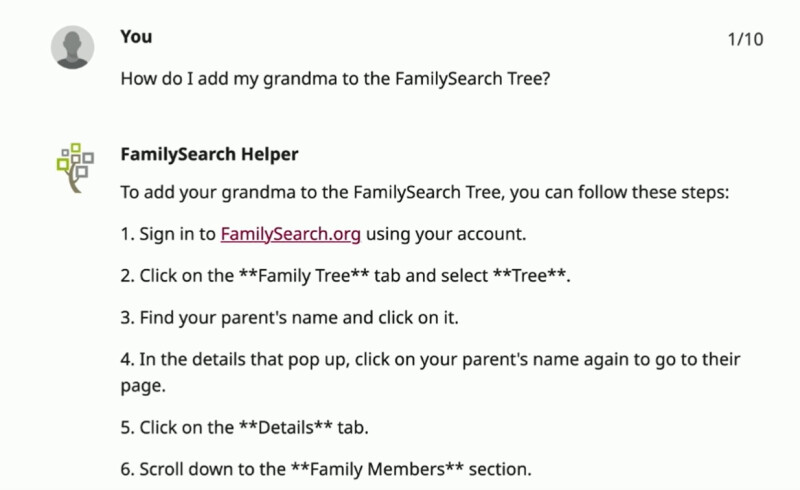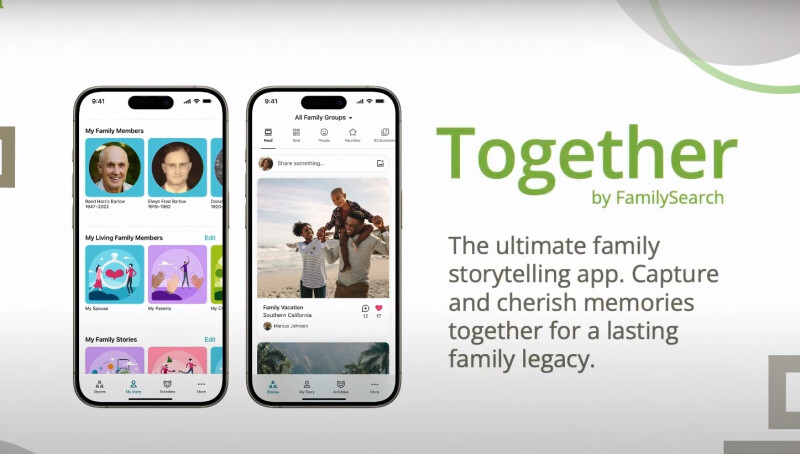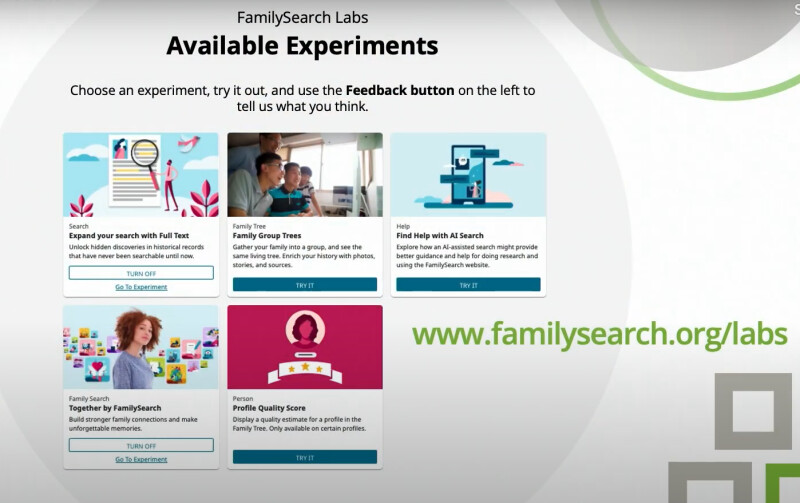FamilySearch highlighted the “Tech” in RootsTech with the first of its main stage forums at the 2024 conference—the FamilySearch Tech Forum. Energy was high as the audience waited eagerly to hear about the latest technology innovations at FamilySearch.
Returning for the second year in a row, RootsTech emcee Kirby Heyborne introduced the forums: “This marks the beginning of an exciting new era where we come together to tackle pressing topics, seek out innovative solutions, and then engage with the experts in the field of family history. And that’s a lot of you here today.”
Kirby noted that over the years FamilySearch has been at the forefront of technological innovation in family history in areas such as records digitization and search algorithms. But the best is yet to come. “As we look to the future,” he said, “we see a horizon filled with endless possibilities.”
Watch the full FamilySearch Tech Forum on RootsTech.org for free, or take a look at the exciting innovations highlighted in the forum by reading on.
Why Innovation?
Bret Weekes, director of software development at FamilySearch, began with a reference to this year’s RootsTech theme: Remember. “Why take time to remember?” Bret observed that remembering our past helps us feel connection and belonging, grounding and purpose. “Remembering can give us continuity in life, and direction for who we are and who we want to become.”
Bret noted that technology innovation has always been present at FamilySearch, but FamilySearch isn’t a tech company; it’s a service organization. The value of innovation is that it enables FamilySearch to help people connect their families, past, present, and future.
How AI Will Facilitate Family History
Generative AI is accelerating the work done at FamilySearch.
Andy Gold, AI portfolio director at FamilySearch, said he’s often asked if FamilySearch fears AI. Andy’s response is that AI is not something to fear; rather, it’s a tool. “Our goal is to connect people,” he explained. “If AI is a utensil in our kitchen, remember: our ‘secret ingredients’ are you, your story, and the love that comes from celebrating and remembering others.” FamilySearch uses AI “deep learning” algorithms to process massive record archives and gain a new understanding of the relationships between people in traditional records, such as censuses and vital records. These algorithms process information more quickly than manual methods or even machine learning extraction methods.

Machine learning is helping to:
- Translate historical documents so users can access records in a language they don’t speak.
- Transcribe records to enable full-text searching.
- Create family trees for entire cities.
- Generate narratives and comprehensive views of ancestry across entire regions.
FamilySearch will continue to explore ways to use generative AI to foster a shared global community by uncovering connectedness between our lives and the lives of our ancestors.
FamilySearch Helper: Your Personal Assistant
Do you ever need help with your family history? How would you like to have a personal assistant available around the clock?
Bill Mangum, product manager of help and learning, described the new FamilySearch Helper, an AI-powered family history expert. FamilySearch Helper answers questions you ask in “natural language”—in other words, language you would use in speaking to another person.
To find answers, FamilySearch Helper searches all FamilySearch help content, including help articles and lessons, the FamilySearch Research Wiki, and the FamilySearch blog. Some RootsTech content has been incorporated, with more to come.
Bill shared several examples to demonstrate how easy it is to get answers with FamilySearch Helper:
For example, you can ask, “How do I add my grandma to the FamilySearch Tree?” Here’s how FamilySearch Helper responds:

Or you can ask a more complicated question, such as “How do I find my German ancestors?”

FamilySearch Helper is revolutionizing the way we find answers to our family history questions. You can try out FamilySearch Helper at FamilySearch Labs (more on Labs below).
Finding Family with Full-Text Search
Billions of FamilySearch historical records have been indexed to make them searchable. But billions more aren’t indexed, making it difficult—if not impossible—to find your family in them. The sheer volume of these records would require many years of volunteers’ time to index them.
Michelle Barber, a user experience designer at FamilySearch, unveiled a new full-text search tool that makes it possible to search these unindexed records. Full-text search uses AI to transcribe images in a fraction of the time it would take a human. Once a record has been transcribed, users can search for any word on a page. Search terms are highlighted in the image and in the transcription.

One of the most exciting aspects of full-text search is that it enables family historians to find under-represented people, such as indigenous peoples and those who were enslaved.
100 million records are currently available in the full-text search pilot, with more on the way. FamilySearch plans to make all their unindexed records searchable with full-text search, where possible.
This new technology is still being developed, and some transcriptions may not be exactly right. But much of the text is right, and the tool is improving all the time. In the future, users will be able to make corrections to AI-generated transcriptions.
Will volunteers still be needed? Yes! Michelle explained that in the future, volunteers will be paired with AI in ways that have never been done before. (Visit Get Involved to see volunteer opportunities.) Visit the FamilySearch Labs to take full-text search for a test drive.
Collaborating with Family Group Trees
FamilySearch carefully protects the privacy of living individuals in Family Tree. However, this protection has also made it challenging for living family members to collaborate with each other. Todd Powell, product manager for Family Tree, announced a long-anticipated new feature that addresses this challenge: family group trees.
Family group trees are private shared trees. Any FamilySearch user can create a family group tree. The creator becomes the group admin and can then invite others to participate.
Only members of the group can see the information in the group tree, which protects their privacy. Members can attach sources and memories. They can also “like” others’ contributions and add comments. In addition, they can connect living people in the family group tree to deceased people in the public tree.
Family group trees also allow more experienced family historians to mentor others in a safe environment. Admins can even assign tasks to group members. It is currently available to try on the FamilySearch Labs.
Bringing Family Closer Together with a New App

Todd also announced a new mobile app called Together. The purpose of the app is to strengthen family bonds through storytelling.
The Together app takes discovery experiences on FamilySearch.org and reformats them in a way youth will enjoy. It also has some new features for families to enjoy, including ways to share family memories and photos with each other.
Try the Together app by visiting the FamilySearch Labs.
FamilySearch Labs
Speaking of FamilySearch Labs, Craig Miller, director of design and engineering, explained more about this exciting new addition to FamilySearch’s offerings. FamilySearch Labs is a way to give users early access to key features. Feedback is strongly encouraged and used to improve these features. It’s easy to give your input with the Feedback button on the left side of the page.
Craig expressed appreciation for the feedback given so far and said that every piece of feedback is reviewed by the development team. He also encouraged users to be kind in giving their feedback. (Remember, real people with feelings read your feedback! They are trying hard to build useful tools for all of us.)
Craig assured users that when they enter information using experimental features, the information is put into the live system. It won’t be lost when the feature stops being experimental and becomes standard.
Finally, at the bottom of the Labs page, there’s a way to share your great ideas. Your ideas are invited and welcome! Ideas from users have been the basis for many features now available on FamilySearch.org.

Q&A
The forum wrapped up with a Q&A session led by Sarah Hammon with Product Marketing. Here are some highlights:
Q: How do you decide what records to make available in full-text search?
A: FamilySearch prioritizes “high value” content—that is, records with information that isn’t easily available elsewhere.
Q: If I need help with FamilySearch, can I still reach a human?
A: Yes, all support channels are still in place. FamilySearch Helper is just another way to get help.
Q: Will AI replace genealogists going forward?
A: No. People can’t be replicated by machines. The role of AI is to augment and accelerate the efforts of genealogists.
Q: Can I access FamilySearch Labs on a mobile device?
A: Yes, in your device’s web browser. However, currently there is not a mobile app for Labs.
Moving into the Future
Is your interest piqued? You’re not alone! As mentioned, you can watch the entire forum on the RootsTech website. And be sure to visit FamilySearch Labs and Get Involved to get familiar with these tools and share your feedback. Be part of creating the amazing future of family history.
At FamilySearch, we care about connecting you with your family, and we provide fun discovery experiences and family history services for free. Why? Because we cherish families and believe that connecting generations can improve our lives now and forever. We are a nonprofit organization sponsored by The Church of Jesus Christ of Latter-day Saints. To learn more about our beliefs, click here.








